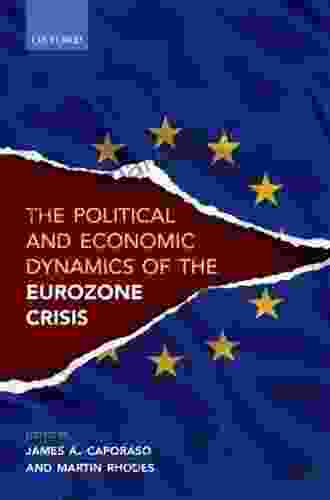Political and Economic Dynamics of the Eurozone Crisis: An In-Depth Exploration

The Eurozone crisis, which erupted in 2009, was a severe financial and economic turmoil that shook the European Union (EU) to its core. The crisis exposed fundamental flaws in the eurozone's monetary and fiscal policies, leading to a prolonged period of economic stagnation, unemployment, and political instability. This article examines the complex political and economic dynamics that fueled the Eurozone crisis and its lasting repercussions.
Economic Roots of the Crisis
The Eurozone crisis originated from a confluence of economic factors. The of the euro in 1999 led to artificially low interest rates in Southern European countries like Greece, Portugal, Spain, and Italy. This cheap credit fueled a borrowing spree, particularly in the real estate sector, creating asset bubbles that eventually burst.
5 out of 5
| Language | : | English |
| File size | : | 7703 KB |
| Text-to-Speech | : | Enabled |
| Enhanced typesetting | : | Enabled |
| Word Wise | : | Enabled |
| Lending | : | Enabled |
| Print length | : | 313 pages |
| Screen Reader | : | Supported |
At the same time, Germany and other Northern European countries benefited from the euro's strength, boosting exports and creating a competitive advantage. This economic divergence within the Eurozone laid the foundation for imbalances and imbalances that later became a catalyst for the crisis.
Political Dynamics
The Eurozone crisis also exposed deep-seated political fault lines within the EU. The crisis revealed contrasting views on economic policy between Northern and Southern European countries. Northern countries favored austerity measures and fiscal discipline, while Southern countries advocated for more expansive fiscal policies to stimulate growth.
The fragmentation of political power within the Eurozone further hampered crisis management. The European Central Bank (ECB) is responsible for monetary policy, while fiscal policy is primarily the responsibility of individual member states. This institutional division complicated policy coordination and slowed down the response to the crisis.
Debt Crisis and Sovereign Risk
The bursting of the real estate bubbles led to a surge in government debt in many Eurozone countries. The resulting sovereign debt crisis threatened the stability of banks and the eurozone financial system. Governments were faced with a dilemma: to bail out banks and assume more debt or to let banks fail and risk a deeper economic crisis.
The ECB's decision to provide liquidity to distressed banks helped prevent a financial collapse. However, it also contributed to increased government borrowing, exacerbating the debt crisis and raising concerns about sovereign risk.
Impact on Economic Growth and Unemployment
The Eurozone crisis had a devastating impact on economic growth and employment. Austerity measures implemented in response to the debt crisis led to cuts in government spending, public sector wages, and social benefits. This austerity led to a sharp contraction in demand, slowing down economic growth and pushing up unemployment rates.
Youth unemployment became a particularly pressing issue in countries like Spain, Greece, and Portugal, where unemployment rates among young people reached alarmingly high levels.
Structural Reforms and Globalization
In response to the crisis, the Eurozone countries implemented a series of structural reforms aimed at improving competitiveness and reducing budget deficits. These reforms included labor market reforms, tax changes, and privatization. However, these reforms often met with resistance from labor unions and social groups, delaying or obstructing their implementation.
The Eurozone crisis also highlighted the challenges posed by globalization. Southern European countries, which had relied heavily on low-cost labor and tourism, faced increased competition from emerging economies. This led to job losses and a decline in living standards in certain sectors.
Policy Responses and Lessons Learned
The Eurozone crisis prompted the EU and its member states to rethink their economic and monetary policies. The ECB adopted more accommodative monetary policies, including quantitative easing, to stimulate economic growth and reduce borrowing costs.
The EU also established new mechanisms to strengthen fiscal discipline and coordinate economic policies among member states. The European Stability Mechanism (ESM) was created to provide financial assistance to countries experiencing financial difficulties.
The crisis highlighted the importance of sound fiscal and monetary policies, as well as the need for closer economic integration and risk-sharing mechanisms within the Eurozone.
The Eurozone crisis was a multifaceted event that exposed the vulnerabilities of the eurozone's monetary and fiscal arrangements. The interplay of economic imbalances, political fragmentation, and the sovereign debt crisis led to a prolonged period of economic turmoil and social hardship.
The lessons learned from the crisis have led to significant reforms in EU economic governance. However, the eurozone continues to face challenges, including the persistence of high debt levels, the uneven pace of economic recovery, and the rise of populism and Euroscepticism. As the Eurozone evolves, it is crucial for policymakers to address these challenges and ensure the long-term stability and prosperity of the European Union.
5 out of 5
| Language | : | English |
| File size | : | 7703 KB |
| Text-to-Speech | : | Enabled |
| Enhanced typesetting | : | Enabled |
| Word Wise | : | Enabled |
| Lending | : | Enabled |
| Print length | : | 313 pages |
| Screen Reader | : | Supported |
Do you want to contribute by writing guest posts on this blog?
Please contact us and send us a resume of previous articles that you have written.
 Top Book
Top Book Novel
Novel Fiction
Fiction Nonfiction
Nonfiction Literature
Literature Paperback
Paperback Hardcover
Hardcover E-book
E-book Audiobook
Audiobook Bestseller
Bestseller Classic
Classic Mystery
Mystery Thriller
Thriller Romance
Romance Fantasy
Fantasy Science Fiction
Science Fiction Biography
Biography Memoir
Memoir Autobiography
Autobiography Poetry
Poetry Drama
Drama Historical Fiction
Historical Fiction Self-help
Self-help Young Adult
Young Adult Childrens Books
Childrens Books Graphic Novel
Graphic Novel Anthology
Anthology Series
Series Encyclopedia
Encyclopedia Reference
Reference Guidebook
Guidebook Textbook
Textbook Workbook
Workbook Journal
Journal Diary
Diary Manuscript
Manuscript Folio
Folio Pulp Fiction
Pulp Fiction Short Stories
Short Stories Fairy Tales
Fairy Tales Fables
Fables Mythology
Mythology Philosophy
Philosophy Religion
Religion Spirituality
Spirituality Essays
Essays Critique
Critique Commentary
Commentary Glossary
Glossary Bibliography
Bibliography Index
Index Table of Contents
Table of Contents Preface
Preface Introduction
Introduction Foreword
Foreword Afterword
Afterword Appendices
Appendices Annotations
Annotations Footnotes
Footnotes Epilogue
Epilogue Prologue
Prologue Sally Hull
Sally Hull Toby Neal
Toby Neal Stephan Weaver
Stephan Weaver Marc Shapiro
Marc Shapiro Mark Phillips
Mark Phillips Philip Butterworth
Philip Butterworth Teen Thrive
Teen Thrive Sherry Cormier
Sherry Cormier Larissa Brown
Larissa Brown Stan Lee
Stan Lee Virginia Lee Horn
Virginia Lee Horn Deborah Garland
Deborah Garland Jocelyn Soriano
Jocelyn Soriano Gail Collins
Gail Collins Kirsten Miller
Kirsten Miller Books By Natalia
Books By Natalia Yusra Laila Visser
Yusra Laila Visser Betina Krahn
Betina Krahn Melinda R Cordell
Melinda R Cordell Jp Robinson
Jp Robinson
Light bulbAdvertise smarter! Our strategic ad space ensures maximum exposure. Reserve your spot today!
 W.H. AudenFollow ·7.2k
W.H. AudenFollow ·7.2k Darren NelsonFollow ·10.5k
Darren NelsonFollow ·10.5k Fernando PessoaFollow ·2.4k
Fernando PessoaFollow ·2.4k Eddie BellFollow ·10.3k
Eddie BellFollow ·10.3k Deion SimmonsFollow ·18.6k
Deion SimmonsFollow ·18.6k F. Scott FitzgeraldFollow ·8.8k
F. Scott FitzgeraldFollow ·8.8k Thomas PowellFollow ·8.1k
Thomas PowellFollow ·8.1k Stanley BellFollow ·8.6k
Stanley BellFollow ·8.6k

 David Mitchell
David MitchellMy Surly Heart: Poetic Expressions of Unrequited Love...
In the annals of...

 Jake Carter
Jake CarterBleach Vol. 50: The Six Fullbringers - A Comprehensive...
Bleach Vol. 50, titled "The Six...

 Edward Reed
Edward ReedThe Art of Simple Food II: A Masterclass in Culinary...
In an era of culinary excess, where meals...

 Jarrett Blair
Jarrett BlairThe Easy Ingredient Ketogenic Diet Cookbook: Your Gateway...
The ketogenic diet,...

 Larry Reed
Larry ReedThe Very Edge Poems Polly Alice Mccann: A Poetic...
An to 'The Very...

 Sidney Cox
Sidney CoxThe Keys of Death and Hades: Unlocking the Epic of...
In the realm of mythology...
5 out of 5
| Language | : | English |
| File size | : | 7703 KB |
| Text-to-Speech | : | Enabled |
| Enhanced typesetting | : | Enabled |
| Word Wise | : | Enabled |
| Lending | : | Enabled |
| Print length | : | 313 pages |
| Screen Reader | : | Supported |












